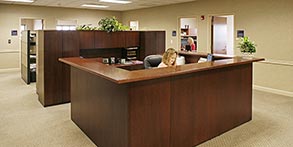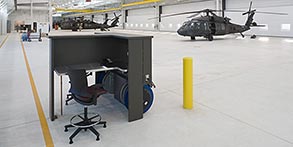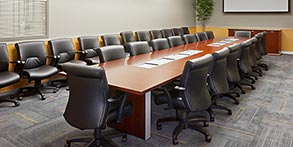- Choose finishes appropriate for the Facility Group and operations; wood finishes may be used in Facility Groups 1, 2, and 4.
- Wood veneers may be used for tabletops in Facility Groups 1 or 2 conference rooms and offices.
- Provide highly durable materials and finishes; use laminate tops with vinyl or wood edges or solid polymer surfaces in high-use applications.
- For administrative spaces limit free-standing furniture to private offices or senior office suites.
- Select wood or laminate furniture, suited to the user’s job function.
- Accommodate work-related storage and desk space, equipment hardware and cabling.
- Select furniture and repetitive units to ensure flexibility; ensure components are interchangeable for greater adaptability to changes in interior layout.
- Use panel or desk-based systems furniture in all open office environments.
- Select manufacturer’s standard products and finishes within a facility.
- Develop team spaces to facilitate communication and create a sense of community while addressing privacy and enclosure.
- 62-inch (nominal) or lower partitions are preferred except where doors are required.
- Ensure chairs are appropriate for the specific use and activity; provide pads or casters suitable for carpet or hard flooring.
All furnishings will be commercial-grade, highly durable, soil-retardant, easily cleanable and not show excessive wear over their useful life. Materials and finishes will serve the specific operational requirements of the space. Commons areas will be furnished consistently with other spaces in the facility.
Coordinate with colors of interior design building finishes and materials in subdued patterns; avoid trendy designs. Wood trim may be used to upgrade supervisory spaces.
New furniture is preferred for new facilities; fully coordinate furniture throughout a facility. Select from Furniture Commodity Council Blanket Purchase Agreement (BPA) and limit the number of manufacturers.
Ensure materials, color, style and functionality are appropriate for the Facility Group and to support the building’s operations.
Sustainability
Furniture construction materials and finishes and upholstery should promote indoor environmental quality. Material specifications should include consideration of environmentally preferable products, products with recycled content, as well as low-emitting and biologically-based products.
Select furnishings with low VOC and with low or no pollutant emissions. This includes all components and sublayers, sealants, finishes, and fabrics for enclosures and partitions, seating, tables and desks, privacy and acoustic panels, storage units, and accessories. Meet or exceed EPA requirements for recycled content. Specify systems and products that fulfill USDA requirements for biobased content while meeting IFS for durability and acoustics.
Resilience
At locations where high humidity is prevalent, avoid the use of furnishing and partitions that delaminate in humid conditions. Do not use ferrous metals that corrode in humid environments. Avoid using materials that fade when exposed to UV light.
UFC 1-200-02 High Performance and Sustainable Building Requirements https://www.wbdg.org/dod/ufc/ufc-1-200-02
UFC 3-120-10 Interior Design https://www.wbdg.org/dod/ufc/ufc-3-120-10
UFC 3-450-01 Noise and Vibration Control https://www.wbdg.org/dod/ufc/ufc-3-450-01
UFC 3-520-01 Interior Electrical Systems https://www.wbdg.org/dod/ufc/ufc-3-520-01
US Air Force Family Housing Design Guide for Planning, Programming, Design and Construction https://www.wbdg.org/FFC/AF/AFDG/familyhousing.pdf








